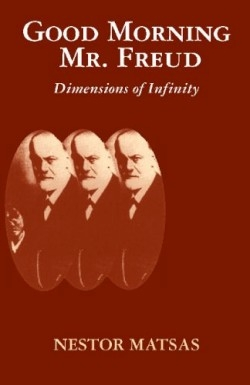
Good Morning Mr. Freud
Dimensions of Infinity
“Curiouser and curiouser,” cried Alice, which best sums up this brief work of arcane fiction. Nestor Mastsas’s Good Morning Mr. Freud: Dimensions of Infinity, translated by Ian Robertson, is termed a “confessionary text” and it is a bit like falling down the rabbit hole of the human psyche. Although absorbing enough as an intriguing account of Freud’s life and work, the book as a “story within a story” is often confusing. Just who is narrating this work and conversing with the other characters? The author himself? Or another third-person omniscient?
Author Matsas (or an anonymous narrator) journeys to Vienna in the late 1970s to unravel the mysteries of his past by studying the works of the late Sigmund Freud.
There, he sees the ghost of his father who was executed in the crematories at the Mauthausen concentration camp. The ghost-father is consulting with Freud on some matter of great importance. The whole scene, with its terrifying, dark theme, is easily reminiscent of the memorable, haunting novel by D.M. Thomas, The White Hotel.
In Vienna, the author (or is it the narrator?) has private “sessions” with the long-deceased Freud by reading and studying his books and papers, bringing theses documents out one-by-one and mulling over some of Freud’s actual cases. To add to the mad tea party here, Freud is referred to interchangeably as “Mr. Freud” (as in the book’s title), “Dr. Freud”, and “The Master” without any apparent order commanding the choice.
To add to the confusion, the book shifts back and forth between Freud-time and 1970s, real time and features crudely-rendered, black-and-while collages throughout the book.
Playing a large role in this work is an unnamed character/patient of Freud’s, The Little Soldier, who experiences a number of traumatic experiences, beginning with the humiliation by his first lover who cruelly ridiculed him at the first sight of his naked, hairless young body. It’s downhill from there with the man experiencing nightmares, fears, and general malaises, including a recurring fantasy of his mother coldly seducing him as a child. The Little Soldier, we are told, is “Freud’s model patient and represents every psychotic person who has not had the opportunity to express himself freely. He creates his own world and, mainly, his nightmares and his own images and illusions.”
The author/narrator begins his psychoanalysis with self-analysis to “plumb the depths of the psychical world with the ultimate aim of knowing yourself.” When all is said and done, it’s an interesting read if you’re willing to work at it. But there is little insight into the inner Freud or the inner reader.
Disclosure: This article is not an endorsement, but a review. The publisher of this book provided free copies of the book and paid a small fee to have their book reviewed by a professional reviewer. Foreword Reviews and Clarion Reviews make no guarantee that the publisher will receive a positive review. Foreword Magazine, Inc. is disclosing this in accordance with the Federal Trade Commission’s 16 CFR, Part 255.
